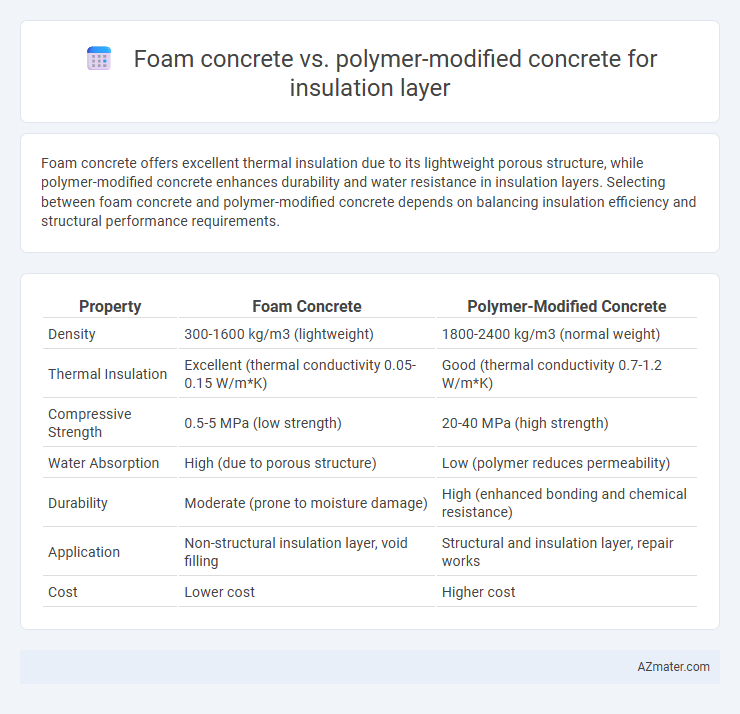Foam concrete offers excellent thermal insulation due to its lightweight porous structure, while polymer-modified concrete enhances durability and water resistance in insulation layers. Selecting between foam concrete and polymer-modified concrete depends on balancing insulation efficiency and structural performance requirements.
Table of Comparison
| Property | Foam Concrete | Polymer-Modified Concrete |
|---|---|---|
| Density | 300-1600 kg/m3 (lightweight) | 1800-2400 kg/m3 (normal weight) |
| Thermal Insulation | Excellent (thermal conductivity 0.05-0.15 W/m*K) | Good (thermal conductivity 0.7-1.2 W/m*K) |
| Compressive Strength | 0.5-5 MPa (low strength) | 20-40 MPa (high strength) |
| Water Absorption | High (due to porous structure) | Low (polymer reduces permeability) |
| Durability | Moderate (prone to moisture damage) | High (enhanced bonding and chemical resistance) |
| Application | Non-structural insulation layer, void filling | Structural and insulation layer, repair works |
| Cost | Lower cost | Higher cost |
Introduction to Insulation Materials in Construction
Foam concrete, characterized by its lightweight and high thermal insulation properties, is widely used as an insulation layer in construction due to its cellular structure that traps air and reduces heat transfer. Polymer-modified concrete enhances durability and moisture resistance by incorporating polymers that improve adhesion and flexibility, making it suitable for insulation layers exposed to harsh environmental conditions. Both materials contribute to energy efficiency, with foam concrete prioritizing thermal insulation and polymer-modified concrete offering improved structural performance in insulation applications.
Understanding Foam Concrete: Composition and Properties
Foam concrete is a lightweight material composed of a cement slurry mixed with pre-formed stable foam, resulting in a low-density structure with excellent thermal insulation and soundproofing properties. Its cellular matrix includes air voids ranging from 70% to 85%, which significantly reduces thermal conductivity and enhances fire resistance. This unique composition makes foam concrete highly effective as an insulation layer in construction, outperforming traditional polymer-modified concrete in terms of weight reduction and energy efficiency.
What is Polymer-Modified Concrete? Key Features and Benefits
Polymer-modified concrete (PMC) is a composite material that incorporates polymer additives to enhance the concrete's properties, making it more durable, flexible, and resistant to water and chemicals compared to traditional foam concrete. Key features of PMC include improved adhesion, reduced permeability, increased tensile strength, and enhanced resistance to cracking and freeze-thaw cycles, making it ideal for insulation layers that require long-term performance and durability. Benefits of polymer-modified concrete include superior insulation effectiveness, extended lifespan in harsh environments, and better structural bonding, which collectively contribute to energy efficiency and maintenance cost savings in building construction.
Thermal Insulation Performance: Foam Concrete vs Polymer-Modified Concrete
Foam concrete exhibits superior thermal insulation performance due to its high porosity and low density, resulting in thermal conductivity values as low as 0.1 to 0.3 W/m*K, making it ideal for insulation layers. Polymer-modified concrete improves durability and mechanical properties but typically has higher thermal conductivity, ranging from 0.5 to 1.0 W/m*K, limiting its efficiency as a thermal insulator. The cellular structure of foam concrete provides better resistance to heat transfer compared to the denser matrix of polymer-modified concrete.
Mechanical Strength Comparison
Foam concrete typically offers lower mechanical strength, ranging from 1 to 10 MPa, due to its high porosity, making it suitable primarily for non-load-bearing insulation layers. Polymer-modified concrete enhances mechanical strength by incorporating polymers that improve matrix cohesion and bonding, often achieving compressive strengths above 20 MPa while maintaining good insulating properties. The superior tensile strength and reduced permeability of polymer-modified concrete provide better durability and load resistance compared to foam concrete in insulation applications.
Durability and Longevity in Insulation Applications
Foam concrete exhibits excellent durability in insulation applications due to its lightweight cellular structure, which resists cracking and thermal degradation over time. Polymer-modified concrete enhances longevity by improving adhesion, reducing permeability, and increasing resistance to freeze-thaw cycles and chemical attacks. In insulation layers, polymer-modified concrete generally outperforms foam concrete in long-term stability, while foam concrete offers superior thermal insulation with lower density.
Application Methods and Workability
Foam concrete offers superior workability with its lightweight, flowable mixture that can be easily pumped or poured into complex formworks, making it ideal for insulation layers in large surface areas or void filling. Polymer-modified concrete improves adhesion and flexibility through additives that enhance bonding properties, often requiring precise mixing techniques and controlled curing processes to optimize its insulating performance. Both materials are chosen based on application demands, where foam concrete excels in rapid placement and lightweight insulation, while polymer-modified concrete suits scenarios requiring enhanced durability and resistance to moisture or chemical exposure.
Cost Analysis: Materials and Installation
Foam concrete offers a cost-effective solution for insulation layers due to its low material price and ease of installation, requiring less specialized labor compared to polymer-modified concrete. Polymer-modified concrete, while providing superior durability and moisture resistance, involves higher material costs and longer installation times driven by the need for precise mixing and curing conditions. The overall cost analysis indicates foam concrete is preferable for budget-sensitive projects, whereas polymer-modified concrete suits applications demanding enhanced performance despite increased expenses.
Environmental Impact and Sustainability Considerations
Foam concrete exhibits lower embodied energy and utilizes recycled materials, making it more environmentally friendly compared to polymer-modified concrete, which relies on synthetic polymers derived from non-renewable resources. The biodegradable nature and lower carbon footprint of foam concrete contribute to greater sustainability in insulation applications, while polymer-modified concrete often faces challenges related to polymer degradation and microplastic pollution. Lifecycle assessments highlight foam concrete's superior performance in reducing greenhouse gas emissions and facilitating eco-friendly construction practices.
Choosing the Right Concrete for Optimal Insulation
Foam concrete offers superior thermal insulation due to its lightweight, porous structure with air voids that reduce heat transfer, making it ideal for insulation layers in buildings. Polymer-modified concrete enhances durability and water resistance, with improved adhesion and flexibility but generally provides lower insulation compared to foam concrete. Selecting the right concrete depends on balancing insulation requirements with mechanical strength, moisture resistance, and application conditions for optimal thermal performance.

Infographic: Foam concrete vs Polymer-modified concrete for Insulation layer
 azmater.com
azmater.com